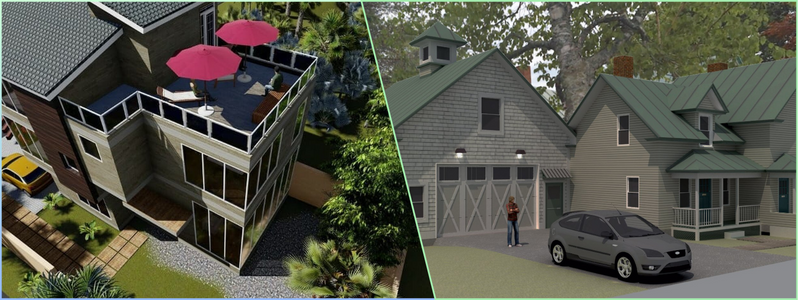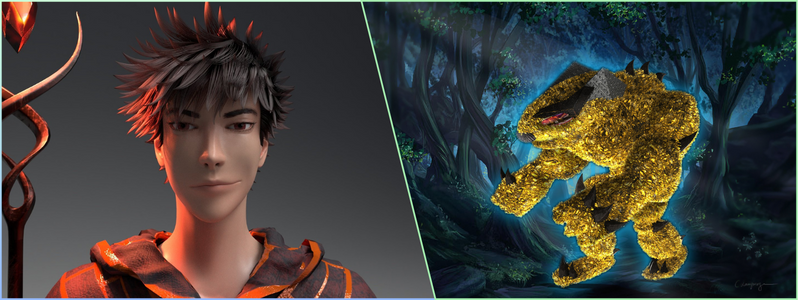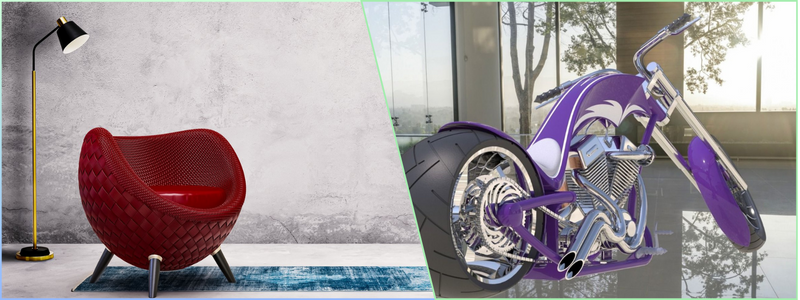3D rendering services and applications allow more interactive experiences by developing three-dimensional digital models of structures, spaces, or objects. These 3D models provide an interactive and realistic representation for better decision-making, communication, and visualization in different fields, including product design, engineering, and architecture. Here’s a quick overview of how various companies and industries embrace 3D rendering services and applications:
Automotive design
3D rendering services and applications, unlike traditional 2D drawings and renders, allow engineering design firms, designers, and customers to experience an interaction with realistic vehicle models even before they are manufactured. This helps and improves the automotive design process, lowers the risk of errors and additional costs, and enhances collaboration and communication. Car makers also make the most of virtual showrooms to offer potential buyers more immersive experiences.
RELATED: CAD automotive design – when driving becomes personal
3D rendering services and applications also let designers develop, tweak, and test detailed virtual engine models as well as other parts of the automotive in real time. Most 3D rendering services are working on the automotive digital twins to develop virtual vehicle models and test their crashworthiness, aerodynamics, and other critical performance metrics.
3D construction rendering
Contractors, engineers, and architects create and share their designs’ digital models using 3D visualization. This allows stakeholders to understand the construction site plans better, reach more educated designs, and pinpoint and solve possible problems even before the start of the construction. Companies use BIM modeling services or building information modeling to let engineers, architects, and other construction experts develop and share meticulous 3D models of the building designs to enable collaborative construction and design.
RELATED: 5 Reasons why your business should use 3D rendering for construction projects
There are also 3D construction rendering experts that use AR/VR to create interactive and immersive tours of the building for both construction companies and potential buyers before the start of the construction. Others also use drones and LiDAR or light detection and ranging to capture accurate data on the site to create complete 3D models. The advances in 3D rendering services and applications help lower costs, spur collaboration, and boost the construction projects’ overall efficiency.

Education
E-learning platforms and institutions use 3D visualization to improve learning, motivation, engagement, and outcomes for teachers and students. Educational institutions use it for different purposes, such as exploration of historical sites, simulation of experiments, visualization of complex concepts, and creation of art projects.
3D rendering services are also developing hologram solutions based on AR and VR to incorporate into the classroom experience. It offers different levels of interactive and immersive learning for students according to their preferences and needs. 3D rendering services also work on virtual classroom setups in a way that allows students to attend classes and get a quality education without stepping outside their homes.
RELATED: Top 20 industries using VR services for business: virtual reality (VR) technology
Entertainment
The industry of entertainment uses 3D imagery for the creation of immersive and realistic experiences for audiences. The 3D models, effects, and animations generated using different techniques and software tools are extensively used in metaverse gaming design, AR/VR applications, TV, and films. 3D rendering services and applications also find use and purpose in TV and film for virtual sets, virtual backgrounds, and special effects. Certain 3D rendering services additionally develop software enabling players to engage with virtual characters and environments in a more instinctive and seamless manner.
Many public attractions, including museums and theme parks, are also starting to use VR and AR to create more immersive attractions and rides. Design companies utilize 3D visualization services to develop interactive and immersive environments for conferences, concerts, and other events. There are also 3D rendering services that develop hardware like mobile apps and wearables that offer more immersive viewing experiences.
Fashion design
Prospective customers and fashion designers view and create realistic digital models of different fashion items, including apparel, clothes, accessories, and shoes, using 3D rendering services and applications. It’s starting to become a critical aspect of the field of fashion as it provides benefits like customization, faster production, and cost reduction. 3D rendering services also innovate fashion design by developing tools and platforms that simplify 3D design, rendering, collaboration, and simulation.
RELATED: Clothing 3D rendering cost, 3D modeling rates & design prices
Clothing retailers also use 3D modeling design firms to design the layouts of their physical stores and their visual merchandising displays. It helps optimize the use of space and create a more engaging shopping environment for the customers. Many 3D rendering services also work on product configurators that let customers personalize and customize their purchases and even try apparel and clothes on virtual models. It creates a more personalized and engaging shopping experience.
Gaming
3D rendering services and applications allow gamers to fully immerse themselves in the virtual worlds and closely interact with lifelike environments and characters via metaverse gaming design. Advanced animation techniques, lighting, and graphics create more realistic 3D character animation and environments that improve the gaming experience. 3D character animation designers try to achieve a realistic gaming experience by implementing 3D visualization in gaming by tapping into VR or virtual reality and AR or augmented reality.
RELATED: Applications of 3D rigging services within the animation, film, and gaming industries
Some 3D rendering services also develop software that allows players to interact with virtual characters and environments more naturally and intuitively. Many also harness the potential of novel methods for displaying and rendering 3D graphics like real-time ray tracing (RTX) and cloud-based gaming. These innovations enhance player experience and open new storytelling and game design possibilities.

Healthcare
Physicians and healthcare experts use 3D visualization tools and 3D printing design services to offer visual representations of the scanned parts of the human body through virtual models. These provide nuance and depth to the usual 2D static medical images. It also makes diagnoses better than before, cuts down the learning curves for surgical operations, lowers operations costs, and shortens image acquisition time. These solutions also support surgical planning and education by delivering insights into patient-specific organ anatomy and pathological changes.
Most 3D rendering services also use AI or artificial intelligence to optimize image processing, analysis, and management and develop 3D medical devices design and animations for marketing and communication. Many hospitals are also starting to leverage imaging platforms using the data from CTA or computed tomography angiography and MRI or magnetic resonance imaging to produce 3D images of the human heart.
RELATED: Medical device design: a guide to service pricing, costs, and rates for companies
Design for manufacturing
3D rendering services and applications in the manufacturing industry allow for the developing of meticulous models of products, facilities, and equipment. Design for manufacturing experts enable manufacturers to analyze and visualize data, determine possible concerns, and streamline production.
Many 3D rendering services use modern technologies, including digital twins, virtual reality, and augmented reality, to create interactive and immersive 3D models. It allows manufacturers to streamline and visualize their operations. The 3D models are used for product design, process optimization, and prototyping. The result is that 3D visualizations remarkably enhance production line visibility and factory efficiency.
RELATED: Why prototype DFM services are useful for product design at companies and firms
Marketing
Advertisers and businesses use 3D product rendering services and applications to showcase their services or products in a visually interactive and appealing way. Brands create immersive and realistic environments, allowing consumers to experience 3D product designs and enhance their decision-making process virtually. It captures customers’ attention, specifically in the automotive, fashion, and real estate industries, where a product’s visual aspect is critical to driving more sales.
Many 3D rendering services use VR and AR to offer consumers more immersive experiences, while others use 3D models to supplement the physical models used for marketing. Some services create AI-powered 3D rendering platforms to assist companies and industries in quickly and efficiently creating photorealistic visualizations.
Retail
3D rendering services and applications allow retailers to showcase and present their products and offerings in various colors, sizes, environments, and angles using 3D product animation professionals. This allows them to offer their target audience a better understanding and glimpse of the products’ features, fit, and quality. Thanks to 3D visualization, retailers can reduce the time and costs associated with inventory management, returns, and product photography. Product models provide retailers with a more precise representation of their inventory, which helps increase the efficiency of order fulfillment, restocking, and product placement.
RELATED: Accessible design: better products for everyone

These models also make it easier to pinpoint damage or defects on the product and identify the best course of action for replacement or repair. Most 3D rendering services leverage 3D visualizations to develop AR tryouts, virtual assistants, product configurators, and web 3D viewers. All of these solutions allow more immersive commerce and enhance customer satisfaction, loyalty, and engagement, resulting in higher conversion rates and more sales.
RELATED: Accessible design: better products for everyone
3D rendering services and applications are entering more companies and industries
3D rendering services and applications are expected to see continued integration, not just in companies and industries, but even in different aspects of the lives of ordinary citizens across the globe. 3D visualization is computationally intensive and requires high-end software and hardware to develop and render more complex models. It makes it more challenging for small and medium enterprises to leverage 3D rendering services without spending vast amounts of money. The good news is that outsourcing these projects is now possible.
How Cad Crowd can help
Cad Crowd is the leading platform that can connect companies and industries with the right 3D rendering professionals who can carry out exceptional 3D rendering services and applications. Contact us for a free quote.
